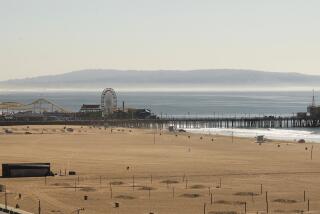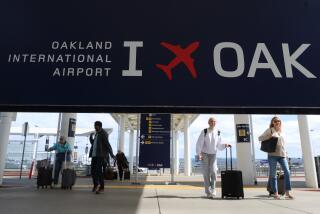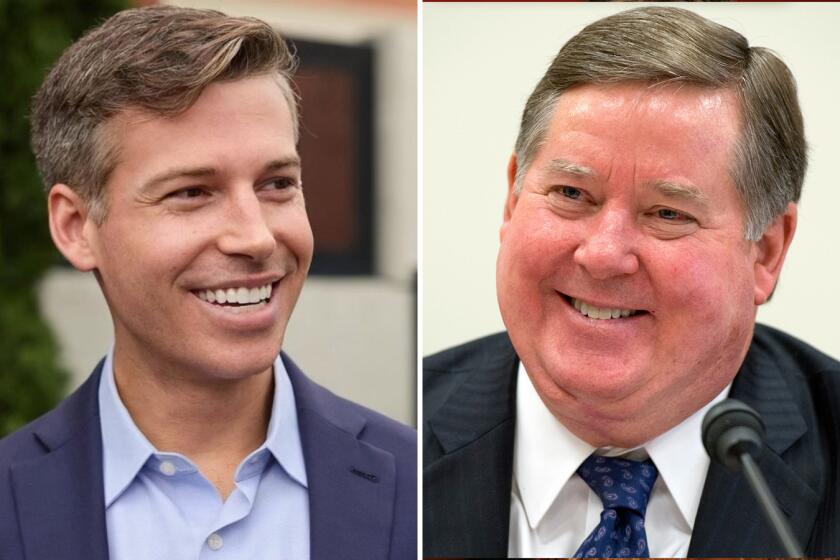Santa Monica launches effort to shut down all or part of city airport
The Santa Monica City Council late Tuesday took a major step toward closing all or part of the city’s airport after July 2015 -- a controversial move that could result in years of additional court battles with the federal government.
On a 6-0 vote, the council decided to develop and evaluate a strategy to scale back flight operations, cut the 5,000-foot runway by 2,000 feet and reduce aviation related services, such as fuel sales and flight schools.
The decision also calls for the city to consider converting airport land to low-impact non-aviation uses. Meanwhile, it will continue a legal effort to gain full control of the facility, which is subject to federal agreements designed to preserve the 227-acre airport, including its 5,000-foot runway.
“We don’t want to be told how to use our property,” Councilman Bob Holbrook said. “I’ve sucked in the kerosene fumes.... I’ve seen the trees turned inside out by jet engines. It’s not an environment we should live in. We need to fight for property that belongs to the city.”
In addition, city officials will consider paying back a $250,000 federal airport improvement grant to free itself from a requirement that the historic facility remain an airport until 2023.
The council approved the reimbursement proposal although City Atty. Marsha Moutrie warned the Federal Aviation Administration has never allowed grant money to be repaid.
Council members said the package of ideas approved Tuesday night was not the final decision to close the airport or scale back operations.
FAA officials declined to comment on the decision. The agency, however, reiterated its longstanding position that under a 1948 agreement, the city is obligated to operate the property as an airport unless the government approves a change in use.
FAA officials say the agreement, which transferred the facility from the government back to the city after World War II, applies to the entire 5,000-foot runway.
City officials say the agreement might not apply to 2,000 feet of runway on the west end, raising the possibility it could be closed.
So far, the FAA has prevailed in every legal attempt by the city to ban certain jets and gain control of the facility. The latest victory occurred last month in federal court.
Moutrie cautioned council members additional litigation was possible if they decided to close the airport and that it could take years, not months, to resolve the legal issues. She added the outcomes would be uncertain.
During the hearing, the debate over the airport’s future played out in full as more than 120 members of the public spoke in favor and against the effort to scale back or close the oldest operating airport in the county.
Opponents of the airport said the facility should be shut down because of noisy overflights, air pollution in surrounding neighborhoods and the potential for deadly crashes in nearby residential areas.
Some speakers were especially concerned about aircraft emissions containing lead and ultrafine particles of black carbon, which have been found at elevated levels around the airport.
Health studies show even low-level exposures to lead can reduce IQ in children, while the tiny soot particles can cause heart and lung problems.
One person likened the airport to Love Canal, the Niagara Falls neighborhood that was heavily contaminated with industrial pollutants in the 1970s. Another speaker who was concerned about safety said that being near the airport was like living in Tel Aviv and waiting for a bomb to go off.
“Every takeoff becomes terrorism,” she said.
Instead of an airport, opponents told the council the property should be converted into a much needed park with playing fields, gardens, walkways, picnic areas and cultural amenities such as an amphitheater.
An environmental liability, they said, would become an environmental asset.
“We are legion, we are many and we will win,” said John Fairweather of Community Against Santa Monica Airport Traffic, which supports the park proposal.
Supporters say the airport is an important part of the county’s transportation system and contributes $250 million annually and 1,600 jobs to the local economy.
They noted the airport provides educational opportunities for children and a base for hundreds of medical-related flights a year.
The concerns about noise and pollution, speakers said, will eventually fade because of the increasing use of unleaded aviation gas and cleaner, quieter aircraft engines.
Some speakers chided airport critics who bought homes near the airport and then complained about noise and aircraft emissions. They also contended that much of the air pollution around the airport comes from nearby highways and major thoroughfares.
Bill Dunn, a high ranking official of the Aircraft Owners and Pilots Assn., and Ed Story of the California Pilots Assn. asserted if the airport were closed, it would clear the way for high-rise development rather than a park -- a proposal they called the “Big Lie.”
Others pointed out that without the airport, height limits on new construction in the area might be lifted, clearing the way for more dense development.
Just before the vote, Councilman Kevin McKeown described Dunn’s and Story’s criticism as a canard and alarmist. If his colleagues approved high-rise projects for the airport site, he said, they would never get reelected.
Twitter: @LADeadline16
More to Read
Sign up for Essential California
The most important California stories and recommendations in your inbox every morning.
You may occasionally receive promotional content from the Los Angeles Times.











